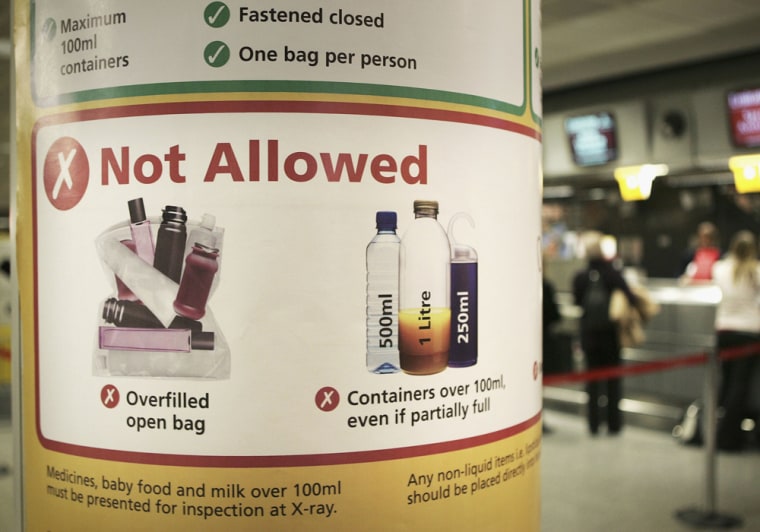Don’t toss that one-quart, zip-top, clear plastic bag just yet. Despite hopeful reports, technological advances and yesterday’s terror-plot convictions in London, TSA won’t be relaxing its 3-1-1 rule on liquids any time soon.
It’s been three years since the 2006 plot to blow up transatlantic airplanes with liquid explosives was uncovered — three years in which we’ve all had to shrink our toiletry kits, pack them in zip-top bags and remove them from our carry-on bags at security.
So, what’s “the path forward on liquids,” as then-TSA Administrator Kip Hawley called it on the agency’s blog late last year? Although Hawley suggested the restrictions could be loosened as early as this fall, it’s safe to say that buying that big bottle of water before security is still a bad idea.
Screening, sniffing and serious spending
As part of the American Recovery and Reinvestment Act, TSA has received $1 billion in funding for aviation security projects, of which approximately $300 million is being directed toward checkpoint-screening technology. (The other $700 million will go toward screening checked baggage.)
In terms of liquids, much of TSA’s efforts are currently focused on so-called Advanced Technology (AT) X-ray machines, which provide improved resolution over traditional X-ray machines. In time, says TSA, they may also be able to distinguish between benign and dangerous liquids through the use of upgradeable software and advanced algorithms.
Currently, AT machines are in use in 875 security lanes (out of 2,225 nationwide) in 78 airports with another 25 machines expected to be in place by the end of the year. As for when those machines might be able to scan liquids well enough to supersede the 3-1-1 rule is anybody’s guess.
“I can envision it being another year to 18 months before you’ll be able to carry your water bottle through security,” says one screening-technology manufacturer who requested anonymity. TSA, however, is less inclined to speculate: “We continue to work with the industry to make sure the algorithms they put forth will meet our strict security standards,” says spokesman Greg Soule.
Meanwhile, TSA also continues to deploy bottled liquid screeners (BLS), handheld units that use chemical “sniffing” technology to detect the particular vapors given off by specific liquids. “Every bottled liquid releases some kind of vapor,” says Michael Moore, manager of transit programs for ICx Technologies. “They all have a signature or fingerprint.”
The idea, says Moore, is to mimic the finely tuned olfactory powers of man’s best friend. “The sophistication of a dog’s brain to detect threats is pretty advanced,” he says, which may explain why ICx’s screener is called Fido PaxPoint.
TSA currently has approximately 250 BLS units in use in 70 airports and expects to have 900 in place by the end of the year. Alas, they’re not designed for primary screening (and would still require that liquids be removed from bags if they were), but rather, for secondary screening when there’s an alarm and for liquids that are exempt from the 3-1-1 rule, such as medications and baby formula.
The path forward
Also on the checkpoint radar are computed tomography (CT) screening machines, which most large airports currently use to screen checked baggage. These units provide fully 3D images and better explosive-detection capability than AT systems, although their larger size and higher price tag remain obstacles to greater deployment.
Greater availability, however, may be in the offing. Last month, Analogic Corp., a maker of signal- and image-processing equipment, announced that it was preparing to deliver a prototype CT machine to TSA that could be used for both checked-bag and passenger-checkpoint screening, making the technology more available for small- and medium-sized airports.
According to proponents, more CT screening will lead to fewer rescans, less secondary screening and, if and when approved by TSA, the ability to distinguish between benign and harmful liquids without removing them from carry-on bags. “Once you put your bag on the belt,” says Mark Namaroff, director of strategic marketing and investor relations, “you should be able to zip through pretty quickly.”
That’s all well and good, suggests security consultant Douglas Laird, but even the best liquids-detection technology misses the larger issue. “The problem TSA faces is that they’re always chasing something that’s already happened,” says Laird. “There are tens of thousands of ways that you could sabotage an airplane.”
Which, of course, only complicates the path forward for airport security in general. New technologies may provide better screening, but they also raise issues of cost, passenger privacy (think whole body imaging) and the best use of limited resources in a volatile, ever-changing environment.
“Whether it’s a piece of technology or an additional layer of security,” says Soule, “we have to have measures in place to address the ever-changing threats that are out there.” In the meantime, the rest of us will likely be left holding our 3-1-1 bags for some time to come.
Rob Lovitt is a frequent contributor to msnbc.com. If you'd like to respond to one of his columns or suggest a story idea, .
